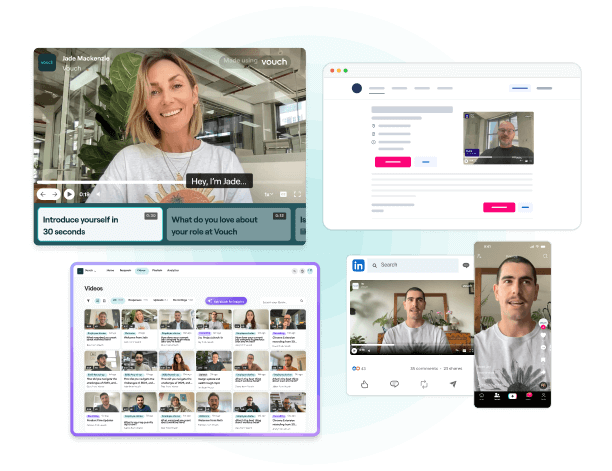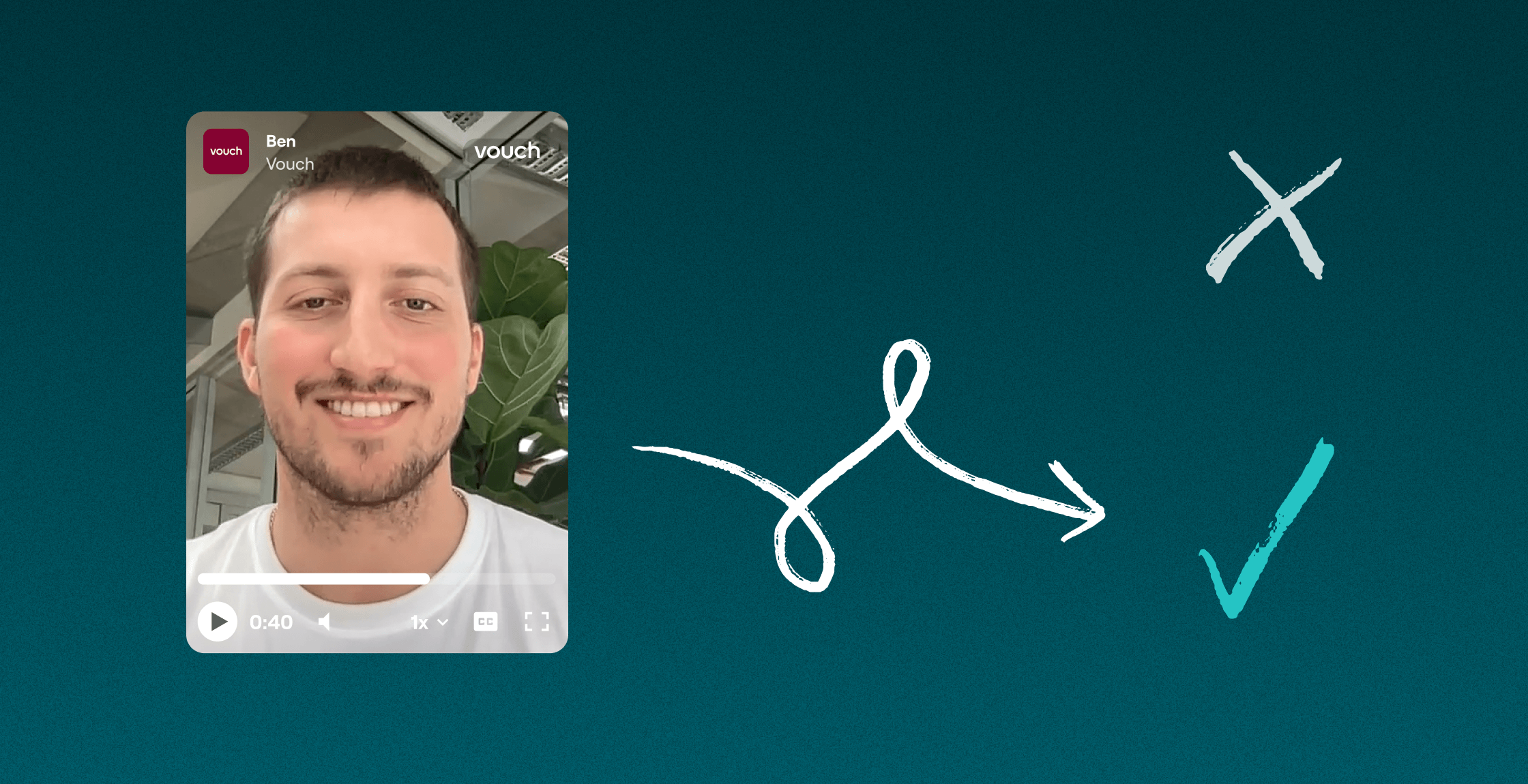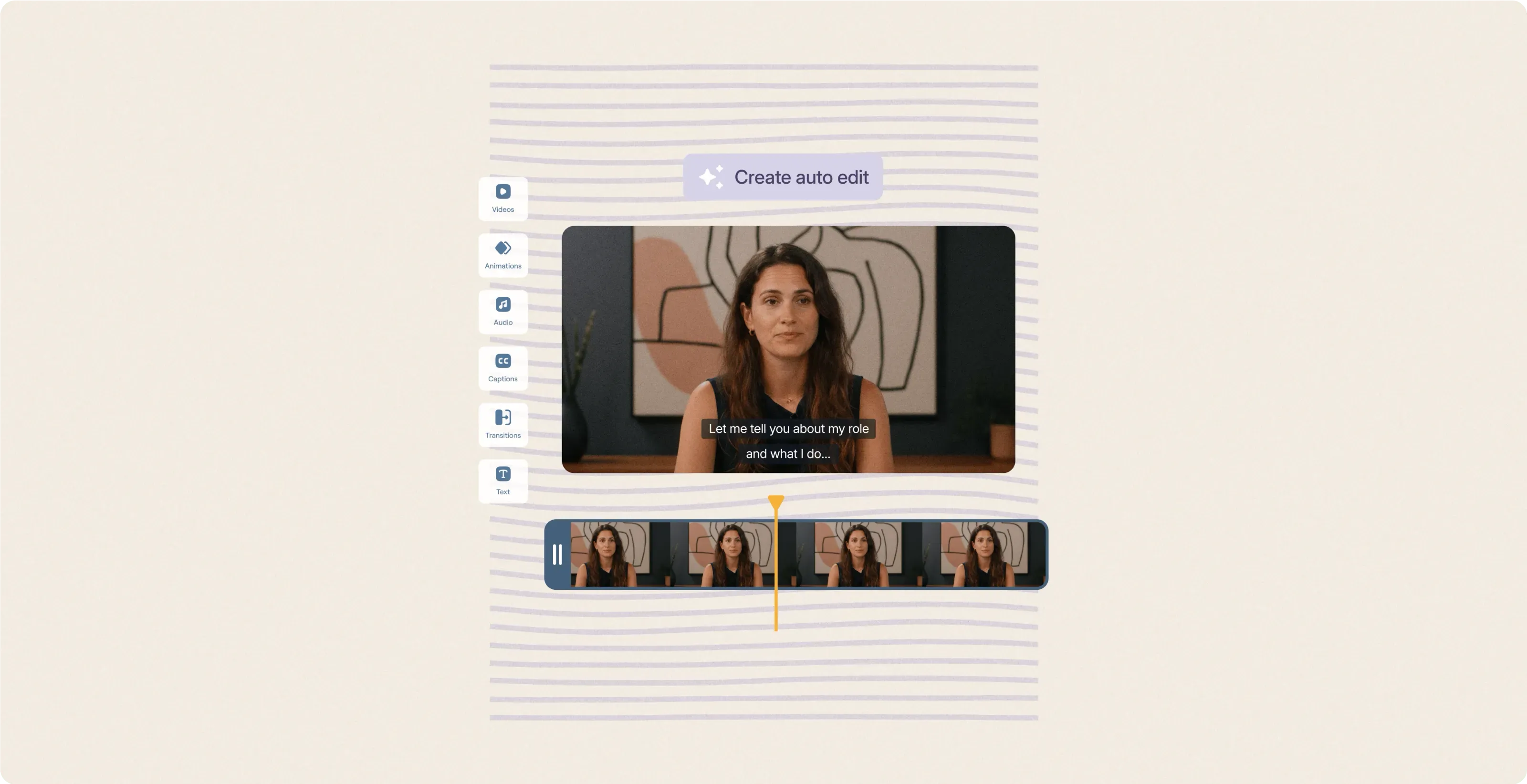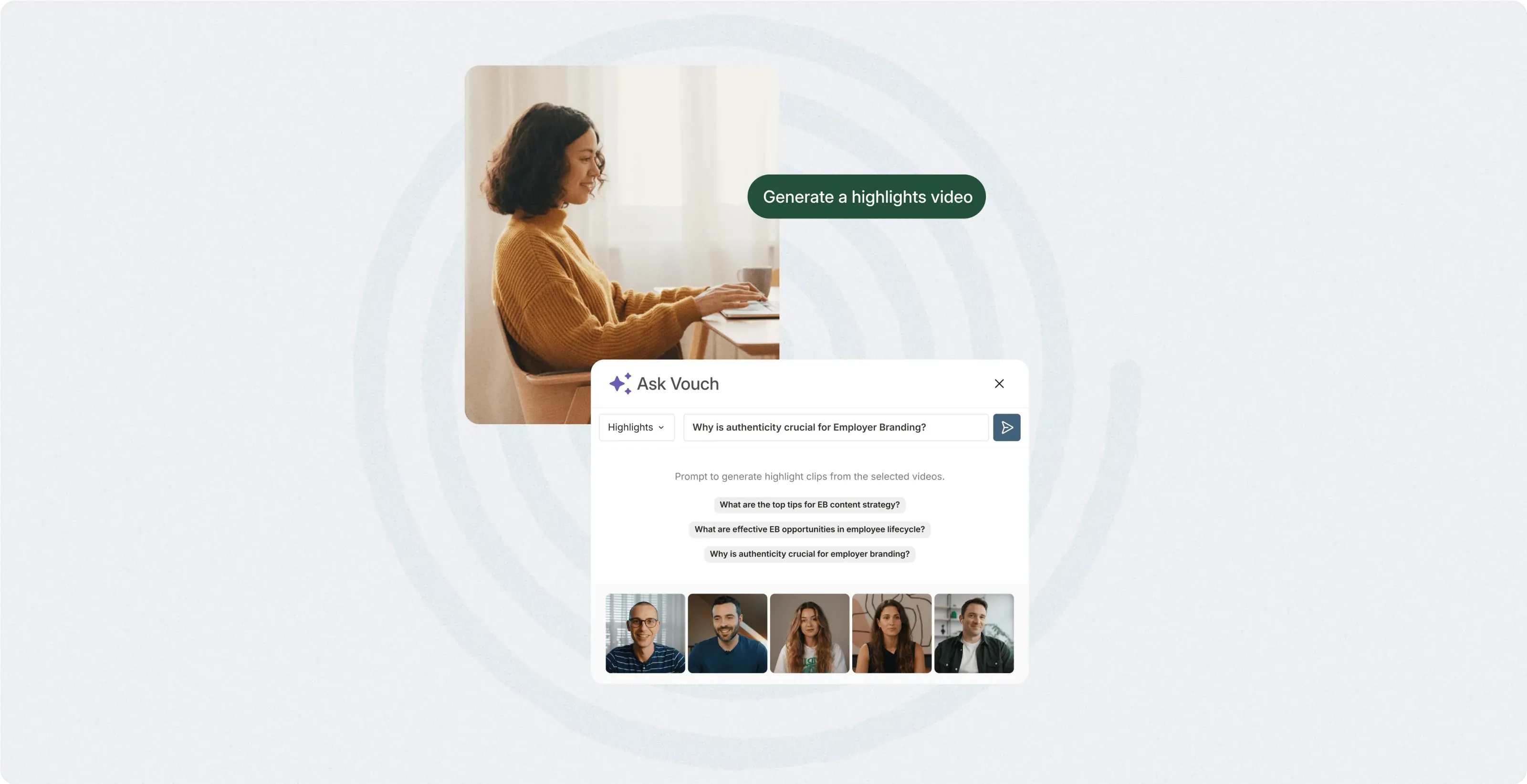While your applicants are working hard to secure a role at your company in 2026, your hiring team is working just as hard to find and secure the right person for your open position.
The entire applicant journey relies on building relationships and building an amazing employer brand and candidate experience. This is also where video platforms like Vouch can showcase your company culture and team, creating a more engaging experience for applicants.
Let's dive in.
What Is The Applicant Journey?
From junior positions to director-level roles, the applicant journey is often the same. But, no matter the role, you want to ensure that your applicant journey is a great experience.
Let's quickly break down what the applicant journey looks like:
1. The applicant sees your position on a jobsite or social media
2. They visit your website, career page and research you further on social media
3. They search employee review sites like Glassdoor
- They usually make a decision here to apply or not
4. They update their resume for the role
5. They submit their resume and cover letter
6. They apply for multiple other roles at the same time
- Your employer brand is everything here to stand out as an employer
7. The applicant gets your communications (and other employers) while waiting
8. They get an initial round-one phone or video interview
8. They make a more formal in-person interview and test process
9. They get or don't get the job
As you can see, the typical applicant journey is extensive, and the overall candidate experience can be daunting for many.
While applying for jobs is fine for job seekers who blast their resumes and aren't too invested in a role, it's not great for more experienced candidates, you know, the ones you want.
These top applicants will likely pour hours into each company and application, so you can quickly see why your applicant journey (and prompt) timiing is everything for securing the right talent.
It's easy to see why 72% of job seekers need a better applicant journey experience, and why 89% of HR leaders agree that a strong employer brand gives them a competitive advantage in attracting top talent. Source: Randstad
What About Your Passive Candidate Experience?
When we look at the applicant journey, we need to consider that there are two groups of job seekers: active and passive.
Depending on your recruitment marketing strategy, often a large portion of the most promising candidates are actually passive, the people that are likely currently employed, working for themselves, or under a contract, and they see your position only through social media channels like Facebook, Instagram, Twitter, YouTube, or another social network.
This means many of the most talented people you can hire, are probably not looking for a job.
Companies that only focus on active candidates are usually missing considerable opportunities to hire the best people.
It's another reason that your applicant journey needs to be a positive experience, nay, a remarkable experience.
Bring your employer brand to life
- Empower employees’ storytelling
- Transform careers sites with video
- AI-driven video editing
- Publish videos anywhere

What Are 5 Ways to Create an Remarkable Applicant Journey?
If you work in HR, Recruitment, Hiring or as a Talent Acquisition manager, you'll know how time-consuming the applicant funnel and screening process can be.
The tips below are designed to help you, not only your applicants.
1. Work on your employer branding
For many candidates, the journey starts with something other than their application; it starts with researching your company.
One study from CR Magazine found that 69% of candidates wouldn't accept a job with a company with a bad reputation, even if they were unemployed. This data says it all.
To create a more positive applicant journey, we need to consider "how" applicants see your company and the many touch points, such as viewing your company's website, reading your reviews, looking at your social profiles, etc.
One surefire way to improve your employer brand is to let your current employees tell their own stories of working at your company.
This is where a tool like Vouch comes in remarkably helpful, as our video tool can do most of the heavy lifting for you and makes social media marketing a breeze.
By using employee testimonials across every single one of your company's touchpoints, you can really start to build your employer brand and get the best talent interested in working for your company.
Making a positive impression is the first step in attracting the right candidates - for both active and passive candidates.
2. Put the candidate at the center of the process
At every stage of the candidate journey, the candidate must be front and center at all the different phases of the recruiting process, or you could risk losing top talent.
For a candidate-centric hiring model, the candidate experience should always come first.
But the point of candidate-centric recruiting isn't just to give them a great experience and make it easier to hire the right person; it's also to build long-term relationships with them so they keep working to land a role at your company, even if they don't get this particular job.
Google is a great example here. Google has been ranked as one of the top companies to work for and giant receives roughly three million applications per year according to this CNBC report. With an acceptance rate of 0.2%, you'd have a better chance of getting into Harvard.
Google of course have an amazing candidate-centric approach, however it's their employer branding that sets them apart and creates this applicant demand.
3. List the needs of the candidate
For most companies, hiring people is about more than just filling seats.
You want to ensure you know what your job candidates want from a perfect role so that they not only onboard with you but stay to flourish - and, in turn, help your company thrive.
Empathy is key here, and you need to ask yourself, "What do your candidates need to know to help them get involved with your company?" "What are their career goals?" and questions like "What kind of career opportunities does my company really offer?"
Forbes conducted a study showing employees want freedom, health care, and a stronger sense of purpose. Remuneration is usually not at the top of an experienced employee's list of needs and wants, and finding out what they need early on in the process makes the candidate's experience much more positive.
In 2026, the trend for job security is also snowballing as we face uncertain financial times. Be sure to know what your candidates really need, on a much deeper level.
4. Apply for your own jobs
Have you ever tried applying for your own job positions?
To be able to put yourself in a candidate's shoes is everything, and this simple process might surprise you.
Companies who undertake this exercise to improve their applicant journey often find problems like having to answer too many questions, can't contact anyone by phone, can't upload certain documents like their cover letter due to the format types (not everyone has Word anymore), or struggle when it comes to file sharing.
We are trying to understand the experience of candidates, so we need to walk in a candidates shoes!
Understanding every step of the candidate's journey is crucial; hiring managers can't simply assume they know the touchpoints candidates experience. Walk a mile in a candidates shoes and you will instantly be able to create a kind of SWOT analysis map of your applicant journey.
5. Create an applicant journey map
Once you've gone through your own job ad review and application process, creating an applicant journey map is one great way to ensure the job application process is as quick and smooth as possible.
For example, you could reduce your processes and time, while giving candidates more power and flexibility as possible over the application process, such as letting candidates set up their own interview times based on your schedule using tools like Calendly.
This can also save you time because you won't have to call and email candidates back and forth. It also puts interview times right on your calendar.
An applicant journey map lets you see what touchpoints a candidate may be going through at each stage of their journey to understand a candidate's behavior, experience, and mindset. Second, it helps your recruitment personal optimize their own workflows for efficiency.
An applicant journey map can be a sketch or used with tools like Canva, and as Canva are one of our clients here at Vouch, we love their software.
How Do You Optimize Your Applicant Short-List Journey?
In the steps above we looked at 80% of the applicant journey process, but what about the remaining 20%, and the next stage the best candidates go through, and even onboarding after you've made a final decision?
Here are five best final steps and onboarding practices to ensure a smooth transition into the new role - and to set the tone for your applicant's journey within the company.
Provide Timely Updates
Keeping applicants informed about their application status is vital, across the multiple candidate journey touchpoints.
By maintaining open communication through your talent acquisition process, from the initial job posting to interactions on social media platforms, you show transparency and respect for their time, which builds trust and keeps potential candidates and passive job seekers engaged.
Leverage Personalized Onboarding
Tailor the onboarding process to each new hire's role and needs as part of their candidate journey. For example, after extending a job offer to an ideal candidate found on job boards, provide personalized training sessions and resources relevant to their position.
This personal touch ensures they feel welcomed and valued, creating a great candidate experience from the start.
Create Interactive Welcome Programs
Implement engaging welcome programs that include virtual meet-and-greets, interactive training sessions, and easy access to resources.
These programs are a great tool in your candidate journey map. By providing clear instructions and support during this phase of the candidate journey, you help new hires feel connected and supported, making their transition smoother and more enjoyable. Highlighting these programs on your careers page and in the application form shows your thought process and commitment to qualified candidates, ensuring they don’t spend too much time feeling uncertain.
Diversity and Inclusion in the Applicant Journey
If you want to enhance diversity and inclusion in your applicant journey, you can create a more welcoming environment for candidates from all backgrounds.
By implementing these principles from the initial job ad post, to the final offer stage, you can attract a broader talent pool and cultivate a more inclusive workplace culture. Embracing diversity ensures that every candidate feels valued and respected throughout the recruitment process. By consciously contributing to diversity and inclusion, you can enrich your applicant journey and reap the benefits of a more varied and dynamic workforce.
Enhancing Candidate Experience through Technology
When it comes to enhancing your applicant journey, incorporating technology like Vouch is key. Also consider leveraging AI for resume screening or CRM technology, you can streamline the initial selection process and provide quick feedback to applicants.
Automated status updates and chatbots also offer real-time engagement, keeping you informed and engaged throughout the process. Additionally, video interviews save time and allow for a more personalized interaction. And don't forget to utilize tech like virtual reality for office tours, which give your applicants and even investors a unique glimpse into the company culture, enhancing your employer brand and overall experience.
FAQs
What is an applicant journey and why is it important for recruitment?
The applicant journey is the process a candidate goes through from discovering a job opening to becoming an employee. It's crucial for recruitment as it helps create a positive candidate experience, boost employer branding, and ultimately attract and retain top talent for the organization.
What are the difference between an active vs passive candidates' journey?
Understanding the distinct paths of active and passive candidates is crucial in recruitment. Active job seekers are proactive in searching for opportunities, while passive candidates may not be actively looking but can be enticed by compelling offers. By tailoring the applicant journey to cater to both groups, recruiters can attract the very best talent.
What are some effective strategies to enhance the applicant journey?
Leveraging technology like applicant tracking systems (ATS) to keep candidates informed and engaged throughout the process can improve the applicant journey. Also, providing a user-friendly application portal and timely updates can significantly enhance their experience and perception of your company.
How can you personalize the recruitment experience for applicants?
You can personalize the recruitment experience by tailoring your internal communication to address each applicant by name and referencing their qualifications and experiences. Additionally, offering individualized feedback and creating opportunities for candidates to engage with your team can make the process more personal and meaningful.
How can you use technology to improve the applicant journey?
Applicant tracking systems (ATS) are invaluable tools that can significantly streamline recruitment for organizations of all sizes. By utilizing an ATS, companies can automate various aspects of the hiring process, such as resume screening, candidate communication, and interview scheduling. This saves time and resources and ensures a more organized and efficient recruitment workflow.
What role does feedback play in enhancing the applicant journey?
Offering timely and constructive feedback to applicants is crucial in helping them recognize their strengths and identify areas for growth. This enhances transparency and provides valuable insights. Personalized feedback demonstrates appreciation for their dedication and maintains their interest, regardless of the outcome of their application.
Additionally, constructive feedback can assist candidates in honing their skills and improving their performance in future job applications. It also creates a positive candidate experience, leaving a lasting impression of professionalism and care on behalf of the organization.
Conclusion
Your employer branding, employee testimonials or spotlight videos, and showing candidates what it's like to work at a company, are some of the most important aspects of the hiring process. If a candidate loves what you do and your workplace culture, they'll eagerly complete your application journey steps.
You need to help candidates to picture themselves in the job, and their daily lives at your company.
And the best way to show candidates what it's like to work in your company is to show the experience of your current employees.
That's where Vouch is ideal, as you can quickly capture employee testimonials and build your employer brand. If you would like to see Vouch in action, book a demo to see why companies like Canva, Amazon, Dropbox, Atlassian, HubSpot, Shopify, and more use our software.
Improve Your Applicant Journey With Vouch!
Loved by companies like Canva, Nike, Cisco, HubSpot, and Amazon, tools like Vouch make leveraging video in your business remarkably easy.
Be sure to book a Vouch demo today and chat with a video content expert.
You might also like

Elevate Your Brand Today With Vouch
Discover how Vouch can accelerate talent acquisition while helping you stay on-brand.






